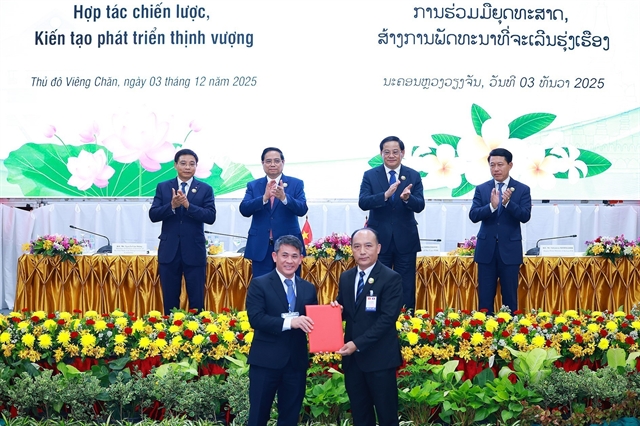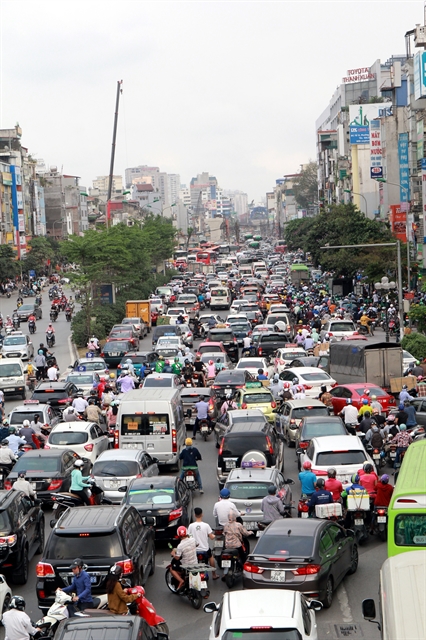 Society
Society


|
| Traffic congestion often occurs on Trường Chinh Street in Hà Nội’s Thanh Xuân District. VNA/VNS Photo Quang Quyết |
HÀ NỘI — Viet Nam's roads may be getting safer, but they're nowhere near safe enough, according to the Prime Minister.
PM Nguyễn Xuân Phúc made it clear that preserving human life is the priority in traffic safety work at an online conference on the country’s transport problems yesterday.
While praising efforts made by the National Committee for Traffic Safety (NCTS), agencies and localities in traffic safety work, Phúc also pointed out shortcomings that need to be solved.
Though traffic accidents and deaths fell respectively by 7.1 per cent and 7.55 per cent in the first half of the year compared to 2018, the total figures of 8,385 accidents and 3,810 deaths were still too high, he said.
The Government leader also noted that congestion was common in large cities and international airports and there were many serious accidents involving coach and trucks, largely due to drivers' lack of awareness.
In addition to wiping out 'black spot' of traffic accidents, it was important to eradicate substandard driver training facilities, he said.
Media reports have featured many such driving schools that promise easy driving test passes to learners.
PM Phúc asked the Ministry of Transport to amend the Law on Road Traffic as this was an important legal framework to handle issues related to traffic safety.
The Ministry of Justice was asked to revise the Law on Handling of Administrative Violations to increase sanctions for violations of traffic safety regulations because some were not strong enough.
Education on traffic safety should focus on the right people and at the right time, he said, adding that businesses in the transport sector must have their own daily traffic safety education programmes for drivers.
The Prime Minister also asked ministries, agencies and localities to speed up the use of information technology in regulating the traffic issues.
Addressing the conference, Nguyễn Văn Thể, Minister of Transport said to overcome shortcoming in transport infrastructure, the ministry would direct its agencies to accelerate the progress of projects to better serve transport activities. The ministry would also regularly work with the Directorate for Roads of Việt Nam and related agencies to eradicate all 'black spots' of traffic accidents.
The ministry had sped up the use of automatic toll collection at toll booths to reduce the risk of traffic disorder and facilitate transportation. The co-ordination between transport agency and localities in controlling vehicle’s load and the fight against unauthorised bus stations had also been strengthened, he said.
Fewer traffic accidents reported
A total of 8,385 traffic accidents were reported nationwide in the first half of this year, resulting in 3,810 deaths and 6,358 injuries, according to the NCTS.
The numbers of accidents, deaths and injuries fell by 7.1 per cent, 7.55 per cent and 9.65 per cent respectively compared to those of the same period last year.
As many as 47 provinces and cities across the country reported fewer deaths relating to traffic accidents than the death tolls during the first half of last year. Eleven other provinces and localities had higher death tolls from traffic accidents.
Among nearly 8,400 reported traffic accidents, 19 were considered “especially serious”, claiming 73 deaths and 87 injured.
These accidents drew public concern as they involved coaches, overloaded trucks, drunk driving and drivers taking drugs.
The National Committee for Traffic Safety also reported 46 major traffic congestion incidents nationwide in this year’s first half, an increase of 17.4 per cent compared to the same period last year.
About 71 per cent of the major traffic jams were due to accidents, another 15.2 per cent was due to high numbers of vehicles while about 13 per cent of the traffic jams were caused by landslides, fires or explosions.
Traffic jams in major cities of Hà Nội, HCM City, Đà Nẵng, Hải Phòng and Nha Trang remain a problem. Coaches picking up or dropping off passengers in the wrong locations outside coach stations, leading to unhealthy competition among coach operators, is another major transport issue.
Limitations of Government bodies in the transport sector were blamed for the problems. For example, transport service providers were not strictly punished when violating regulations and poor co-operation among agencies resulted in improper law enforcement in the transport sector. — VNS




